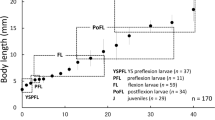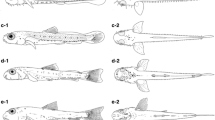Abstract
The growth and morphological development of larval and juvenileEpinephelus bruneus were examined in a hatchery-reared series. Average body length (BL) of newly-hatched larvae was 1.99 mm, the larvae growing to an average of 3.96 mm by day 10, 6.97 mm by day 20, 12.8 mm by day 30, 22.1 mm by day 40 and 24.7 mm by day 45 after hatching. Newly-hatched larvae had many mucous cells in the entire body epidermis. By about 4 mm BL, the larvae had developed pigment patterns peculiar to epinepheline fishes, including melanophores on the dorsal part of the gut, on the tips of the second dorsal and pelvic fin spines, and in a cluster on the ventral surface of the tail. Spinelets on the second dorsal and pelvic fin spines, the preopercular angle spine and the supraocular spine, had started to develop by about 6 mm BL. The notochord tip was in the process of flexion in larvae of 6–8 mm BL, by which time major spines, pigments and jaw teeth had started to appear. Fin ray counts had attained the adult complement at 10 mm BL. After larvae reached 17 mm BL, elements of juvenile coloration in the form of more or less densely-pigmented patches started to appear on the body. Squamation started at 20 mm BL. Major head spines had disappeared or became relatively smaller and lost their serrations by 20–25 mm BL.
Similar content being viewed by others
Literature Cited
Fukuhara, O., T. Nakagawa and T. Fukunaga. 1986. Larval and juvenile development of yellowtail reared in the laboratory. Bull. Japan. Soc. Sci. Fish., 52: 2091–2098.
Fukuhara, O. and T. Fushimi. 1988. Fin differentiation and squamation of artificially reared grouper,Epinephelus akaara. Aquaculture, 69: 379–386.
Hussain, N. A. and M. Higuchi. 1980. Larval rearing and development of brown-spotted grouper,Epinephelus tauvina (Forsskâl). Aquaculture, 19: 339–350.
Ingram, G. A.. 1980. Substances involved in the natural resistance of fish to infection-a review. J. Fish. Biol., 16: 23–60.
Johnson, G. D. and P. Keener. 1984. Aid to the identification of American grouper larvae. Bull. Mar. Sci., 34: 106–134.
Kaji, T., K. Yamaoka, T. Isshiki and T. Yamada. 1995. Mucus cell development on the body surface of the redspotted grouper,Epinephelus akaara. Bull. Mar. Sci. Fish., Kochi Univ., (15): 117–120.
Kawamura, K. and K. Hosoya, 1991. A modified double staining technique for making a transparent fish-skeletal specimen. Bull. Natl. Res. Inst. Aquaculture, (20): 11–18 (in Japanese with English abstract).
Kayano, Y. 1988. Development of mouth parts and feeding in the larval and juvenile stages of red spotted grouper Epinephelus akaara. Bull. Fish. Exp. Sta. Okayama Pref., 3: 55–60. (In Japanese.)
Kendall, A. W., Jr., E. H. Ahlstrom and H. G. Moser, 1984. Early life history of fishes and their characters. Pages 11–12in H. G. Moser, W. J. Richards, D. M. Cohen, M. P. Fahay, A. W. Kendall, Jr. and S. L. Richardson, eds. Ontogeny and systematics of fishes. Am. Soc. Ichthyol. Herpetol., Spec. Publ., No. 1.
Kitajima, C., M. Takaya, Y. Tsukashima and T. Arakawa. 1991. Development of eggs, larvae and juveniles of the grouper,Epinephelus septemfasciatus, reared in the laboratory. Japan. J. Ichthyol., 38: 47–55 (In Japanese with English abstract.)
Kohno, H., Y. Taki, Y. Ogasawara, Y. Shirojo, M. Taketomi and M. Inoue. 1983. Development of swimming and feeding functions in larval,Pagrus major. Japan. J. Ichthyol., 30: 47–60.
Kohno, H., S. Diani and A. Supriatna. 1993. Morphological development of larval and juvenile grouper,Epinephelus fuscoguttatus. Japan. J. Ichthyol., 40: 307–316.
Kohno, H., R. Ordonio-Aguilar, A. Ohno and Y. Taki. 1996. Osteological development of the feeding apparatus in early stage larvae of the seabass,Lates calcarifer, Ichthyol. Res., 43: 1–9.
Kohno, H., R. S. Ordonio-Aguilar, A. Ohno and Y. Taki. 1997. Why is grouper larval rearing difficult?: an approach from the development of the feeding apparatus in early stage larvae of the grouper,Epinephelus coioides. Ichthyol. Res., 44: 267–274.
Leis, J. M. and D. S. Rennis. 1983. The larvae of Indo-Pacific coral reef fishes. New South Wales Univ. Press, Kensington and Univ. of Hawaii Press, Honolulu. v+269 pp.
Manabe, S. and A. Kasuga. 1988. Spawning behavior and early life history ofEpinephelus moara in an aquarium. J. Japan. Assoc. Zool. Gardens Aquariums, 30: 16–24. (In Japanese with English abstract.)
Okada, T., H. Yoneshima, S. Miyashita and O. Murata. 1994. Effects of shelter placement and shading to the rearing tank of kelp grouper,Epinephelus moara. Bull. Fish. Lab. Kinki Univ., 4: 119–125. (In Japanese with English abstract.)
Okada, T., H. Yoneshima, Y. Mukai and Y. Sawada. 1996. Tolerance limits of young kelp grouperEpinephelus moara for environmental stress. Bull. Fish. Lab. Kinki Univ., 5: 139–146. (In Japanese with English abstract.)
Pickering, A. D. and R. H. Richards. 1977. Factors influencing the structure, function and biota of the salmonid epidermis. Proceedings of the Royal Society of Edinburgh, 79B: 93–104.
Powell, A. B. and J. W. Tucker, Jr. 1992. Egg and larval development of laboratory-reared nassau grouper,Epinephelus striants (Pisces, Serranidae). Bull. Mar. Sci., 50: 171–185.
Randall, J. E. and P. C. Heemstra. 1991. Revision of Indo-Pacific groupers (Perciformes: Serranidae: Epinephelinae), with descriptions of five new species. Indo-Pacific Fishes, 20: 1–332, pls. 1–41.
Rosen, M. W. and N. Y. Cornford. 1971. Fluid friction of fish slime. Nature, 234: 49–51.
Sano, S.. 1985. Carbohydrates. Pages 452–472in Histological Techniques—Theoretical and Applied. Nanzando Company Limited, Tokyo, Japan. (In Japanese.)
Senou, H.. 1995. Serranidae. Pages 601–632,in T. Nakabo, ed. Fishes of Japan with pictorial keys to the species (revised edition). Tokai University Press, Tokyo Japan. (In Japanese.)
Shirota, A.. 1970. Studies on the mouth size of fish larvae. Bull. Japan. Soc. Sci. Fish., 36: 353–368. (In Japanese.)
Takaya, M. 1987. Problems in seed production of the redspotted grouper,Epinephelus akaara. Seikaiku-burokku-senkaikaihatsukaigi Gyorui-kenkyukaihou (Fish Research Bulletin of Seikai Regional Research and Development Council), 5: 39–41. (In Japanese.)
Tsukashima, Y. and N. Yoshida. 1984. Masculinization of small kelp grouperEpinephelus moara through oral administration of methyltestosterone. Bull. Nagasaki Pref. Inst. Fish., 10: 101–102. (In Japanese.)
Author information
Authors and Affiliations
About this article
Cite this article
Sawada, Y., Kato, K., Okada, T. et al. Growth and morphological development of larval and juvenileepinephelus bruneus (perciformes: Serranidae). Ichthyological Research 46, 245–257 (1999). https://doi.org/10.1007/BF02678510
Received:
Revised:
Accepted:
Issue Date:
DOI: https://doi.org/10.1007/BF02678510




